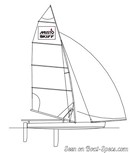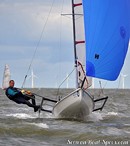Musto Skiff
Sailboat specifications
The Musto Skiff is a 14’11” (4.55m) single handed skiff (dinghy) designed by Light skiff (Germany). She is built since 2000 by Ovington Boats (United Kingdom).
Musto Skiff's main features
- Model
- Musto Skiff
- Hull type
- Monohull
- Category
- Single handed skiff (dinghy)
- Sailboat builder
- Sailboat designer
- Sailboat collection
- Country
- United Kingdom
- Construction
- Fiberglass reinforced epoxy:
- Hull: Sandwich foam fiberglass epoxy with carbon fiber reinforcements
- Deck: Sandwich foam fiberglass epoxy with carbon fiber reinforcements - First built hull
- 2000
- Last built hull
- Still in production
- Appendages
- Centerboard : daggerboard
- Helm
- Single tiller
- Rudder
- Single transom hung rudder
- Unsinkable
- No
- Trailerable
- Yes
- EC design categoryiThe CE design category indicates the ability to cope with certain weather conditions (the sailboat is designed for these conditions)
A: Wind < force 9, Waves < 10m
B: Wind < force 8, Waves < 8m
C: Wind < force 6, Waves < 4m
D: Wind < force 4, Waves < 0,5m - C
- Standard public price ex. VAT (indicative only)
- About11 000 €(2020)
Musto Skiff's main dimensions
- Hull length
- 14’ 11”4.55 m
- Waterline length
- 14’4.26 m
- Beam (width)
- 7’ 8”2.35 m
- Draft
- 3’ 6”1.07 m
- Mast height from DWL
- 23’ 2”7.06 m
- Overall width folded
- 4’ 5”1.35 m
- Light displacement (MLC)
- 183 lb83 kg
- Capacity
- 353 lb160 kg
Musto Skiff's rig and sails
- Upwind sail area
- 127 ft²11.8 m²
- Downwind sail area
- 294 ft²27.3 m²
- Mainsail area
- 127 ft²11.8 m²
- Asymmetric spinnaker area
- 167 ft²15.5 m²
- Rigging type
- Cat boat Marconi
- Mast configuration
- Mast foot integrated on deck
- Rotating spars
- No
- Number of levels of spreaders
- 1
- Spreaders angle
- Swept-back
- Spars construction
- Carbon fiber spars
- Standing rigging
- 1x19 strand wire continuous
Musto Skiff's performances
- Crew
- 1
- Trapezes
- 1 set(s)
- D-PN ratingiDPN is a variation of Portsmouth Yardstick used in the United States.
- 847.0
- Upwind sail area to displacementiThe ratio sail area to displacement is obtained by dividing the sail area by the boat's displaced volume to the power two-thirds.
The ratio sail area to displacement can be used to compare the relative sail plan of different sailboats no matter what their size.
Upwind: under 18 the ratio indicates a cruise oriented sailboat with limited performances especially in light wind, while over 25 it indicates a fast sailboat. - 667 ft²/T62.01 m²/T
- Downwind sail area to displacementiThe ratio sail area to displacement is obtained by dividing the sail area by the boat's displaced volume to the power two-thirds.
The ratio sail area to displacement can be used to compare the relative sail plan of different sailboats no matter what their size. - 1544 ft²/T143.48 m²/T
- Displacement-length ratio (DLR)iThe Displacement Length Ratio (DLR) is a figure that points out the boat's weight compared to its waterline length. The DLR is obtained by dividing the boat's displacement in tons by the cube of one one-hundredth of the waterline length (in feet).
The DLR can be used to compare the relative mass of different sailboats no matter what their length:
a DLR less than 180 is indicative of a really light sailboat (race boat made for planning), while a DLR greater than 300 is indicative of a heavy cruising sailboat. - 30
- Critical hull speediAs a ship moves in the water, it creates standing waves that oppose its movement. This effect increases dramatically the resistance when the boat reaches a speed-length ratio (speed-length ratio is the ratio between the speed in knots and the square root of the waterline length in feet) of about 1.2 (corresponding to a Froude Number of 0.35) . This very sharp rise in resistance, between speed-length ratio of 1.2 to 1.5, is insurmountable for heavy sailboats and so becomes an apparent barrier. This leads to the concept of "hull speed".
The hull speed is obtained by multiplying the square root of the waterline length (in feet) by 1.34. - 5.01 knots
Musto Skiff's auxiliary engine
- Engine(s)
- No engine
Musto Skiff's accommodations and layout
- Cockpit
- Aft cockpit with racks


Ovington Boats Musto Skiff - - 1/11
Picture extracted from the commercial documentation © Ovington Boats
Picture extracted from the commercial documentation © Ovington Boats


Ovington Boats Musto Skiff sailplan - - 2/11
Picture extracted from the commercial documentation © Ovington Boats
Picture extracted from the commercial documentation © Ovington Boats


Ovington Boats Musto Skiff sailing - - 3/11
Picture extracted from the commercial documentation © Ovington Boats
Picture extracted from the commercial documentation © Ovington Boats


Ovington Boats Musto Skiff sailing - - 4/11
Picture extracted from the commercial documentation © Ovington Boats
Picture extracted from the commercial documentation © Ovington Boats


Ovington Boats Musto Skiff sailing - - 5/11
Picture extracted from the commercial documentation © Ovington Boats
Picture extracted from the commercial documentation © Ovington Boats


Ovington Boats Musto Skiff sailing - - 6/11
Picture extracted from the commercial documentation © Ovington Boats
Picture extracted from the commercial documentation © Ovington Boats


Ovington Boats Musto Skiff sailing - - 7/11
Picture extracted from the commercial documentation © Ovington Boats
Picture extracted from the commercial documentation © Ovington Boats


Ovington Boats Musto Skiff sailing - - 8/11
Picture extracted from the commercial documentation © Ovington Boats
Picture extracted from the commercial documentation © Ovington Boats


Ovington Boats Musto Skiff sailing - - 9/11
Picture extracted from the commercial documentation © Ovington Boats
Picture extracted from the commercial documentation © Ovington Boats


Ovington Boats Musto Skiff sailing - - 10/11
Picture extracted from the commercial documentation © Ovington Boats
Picture extracted from the commercial documentation © Ovington Boats


Ovington Boats Musto Skiff cockpit - - 11/11
Picture extracted from the commercial documentation © Ovington Boats
Picture extracted from the commercial documentation © Ovington Boats
Similar sailboats that may interest you:
Sailboats
First built hull
Hull length
2001
15’ 8”4.8 m
1994
14’ 10”4.52 m
1995
13’ 1”4 m
2010
14’ 1”4.3 m
2002
15’ 5”4.68 m
2001
13’ 11”4.25 m
1998
14’ 7”4.44 m
2014
13’ 10”4.2 m
1992
16’ 5”5 m
2006
14’ 2”4.34 m
2015
14’4.27 m
2009
13’ 11”4.23 m
1995
15’ 2”4.64 m
2017
14’ 1”4.3 m
2013
10’ 6”3.2 m